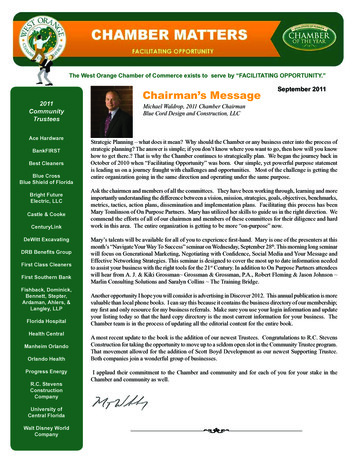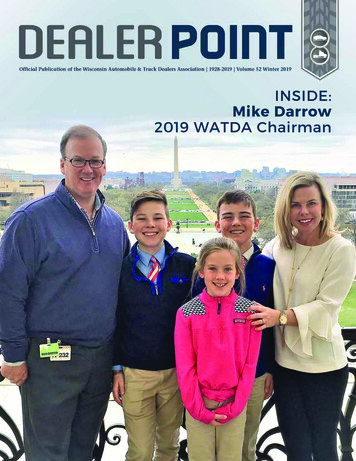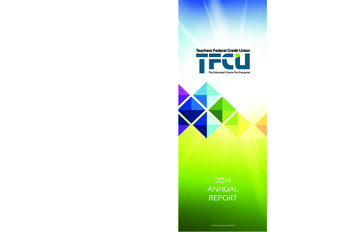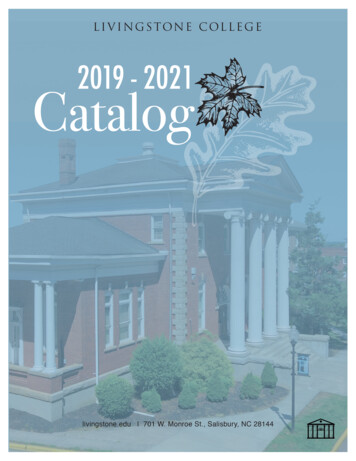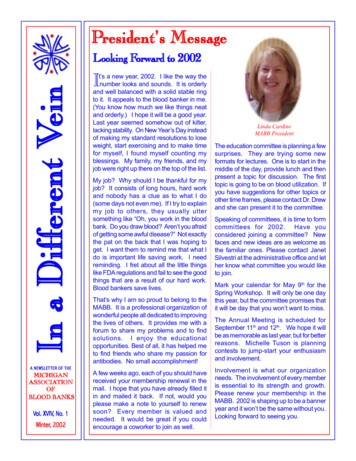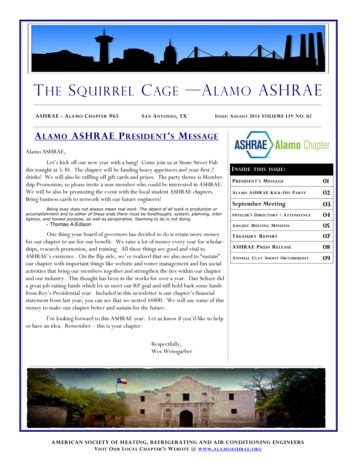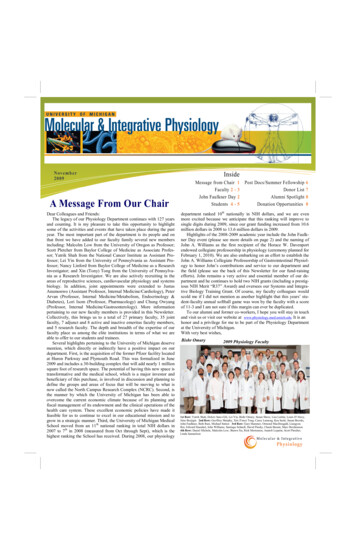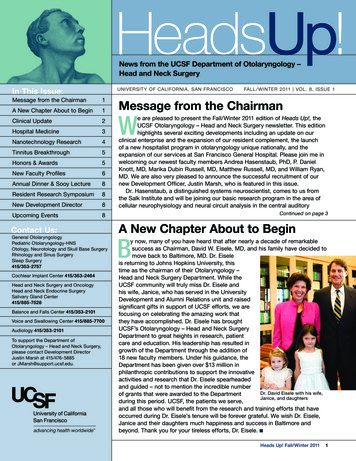
Transcription
News from the UCSF Department of Otolaryngology –Head and Neck SurgeryIn This Issue:UNIVERSIT Y OF CALIFORNIA , SAN FR ANCISCOMessage from the Chairman1A New Chapter About to Begin1Clinical Update2Hospital Medicine3Nanotechnology Research4Tinnitus Breakthrough5Honors & Awards5New Faculty Profiles6Annual Dinner & Sooy Lecture8Resident Research Symposium8New Development Director8Upcoming Events8Contact Us:General OtolaryngologyPediatric Otolaryngology-HNSOtology, Neurotology and Skull Base SurgeryRhinology and Sinus SurgerySleep Surgery415/353-2757Cochlear Implant Center 415/353-2464Head and Neck Surgery and OncologyHead and Neck Endocrine SurgerySalivary Gland Center415/885-7528Balance and Falls Center 415/353-2101Voice and Swallowing Center 415/885-7700Audiology 415/353-2101To support the Department ofOtolaryngology – Head and Neck Surgery,please contact Development DirectorJustin Marsh at 415/476-5885or JMarsh@support.ucsf.edu.FALL / WINTER 2011 VOL. 8, ISSUE 1Message from the ChairmanWe are pleased to present the Fall/Winter 2011 edition of Heads Up!, theUCSF Otolaryngology – Head and Neck Surgery newsletter. This editionhighlights several exciting developments including an update on ourclinical enterprise and the expansion of our resident complement, the launchof a new hospitalist program in otolaryngology unique nationally, and theexpansion of our services at San Francisco General Hospital. Please join me inwelcoming our newest faculty members Andrea Hasenstaub, PhD, P. DanielKnott, MD, Marika Dubin Russell, MD, Matthew Russell, MD, and William Ryan,MD. We are also very pleased to announce the successful recruitment of ournew Development Officer, Justin Marsh, who is featured in this issue.Dr. Hasenstaub, a distinguished systems neuroscientist, comes to us fromthe Salk Institute and will be joining our basic research program in the area ofcellular neurophysiology and neural circuit analysis in the central auditoryContinued on page 3A New Chapter About to BeginBy now, many of you have heard that after nearly a decade of remarkablesuccess as Chairman, David W. Eisele, MD, and his family have decided tomove back to Baltimore, MD. Dr. Eiseleis returning to Johns Hopkins University, thistime as the chairman of their Otolaryngology –Head and Neck Surgery Department. While theUCSF community will truly miss Dr. Eisele andhis wife, Janice, who has served in the UniversityDevelopment and Alumni Relations unit and raisedsignificant gifts in support of UCSF efforts, we arefocusing on celebrating the amazing work thatthey have accomplished. Dr. Eisele has broughtUCSF’s Otolaryngology – Head and Neck SurgeryDepartment to great heights in research, patientcare and education. His leadership has resulted ingrowth of the Department through the addition of18 new faculty members. Under his guidance, theDepartment has been given over 13 million inphilanthropic contributions to support the innovativeactivities and research that Dr. Eisele spearheadedand guided – not to mention the incredible numberDr. David Eisele with his wife,of grants that were awarded to the DepartmentJanice, and daughtersduring this period. UCSF, the patients we serve,and all those who will benefit from the research and training efforts that haveoccurred during Dr. Eisele’s tenure will be forever grateful. We wish Dr. Eisele,Janice and their daughters much happiness and success in Baltimore andbeyond. Thank you for your tireless efforts, Dr. Eisele. nHeads Up! Fall/Winter 20111
Clinical UpdateDr. Andrew Murr: Excellence Across the DepartmentIam proud to share that our clinicalbreadth and depth has never beenstronger as our clinical coverageand excellence accelerates.Beginning in July 2011, we nowhave 22 full time clinicians practicingin all areas of Otolaryngology –Head and Neck Surgery.Our new Chief of facialplastic surgery, P. DanielKnott, MD, from ClevelandClinic arrived this summer.An expert at cosmeticsurgery, Dan is also asenior microvascular andreconstructive expert. He isinnovative, and will be anextremely exciting additionto our clinical service andour educational program.We are very pleased to haveWill Ryan, MD joining us in theDivision of Head and Neck Oncology.Will completed his head and neckfellowship here having previouslyfinished his Otolaryngology –Head and Neck Surgery trainingat Stanford University. Will hasbecome familiar with roboticsurgery, in partnership with SteveWang, MD, and is an outstandingclinical researcher and teacher.The department has also recentlyhired the Russell team. Drs. Matthewand Marika Russell were both ChiefResidents at UCSF. They are bothoutstanding and talented cliniciansand we were very fortunate to haveNews from the UCSFDepartment of Otolaryngology –Head and Neck SurgeryFALL / WINTER 2011 VOL. 8, ISSUE 1Department Chairman, Editor in Chief:David W. Eisele, MDContributors: Matt Forbush, Jennifer Lo,Justin MarshDesign: Laura Myers DesignPhotography: Matt Forbush, Carmen Holthttp://ohns.ucsf.edu 2011 The Regents of the University of California2Heads Up! Fall/Winter 2011“ Our clinical breadthand depth has neverbeen stronger.”attracted both to ourdepartment, albeit, indifferent roles. Matt willconcentrate on qualityissues in collaboration with BobWachter, MD (author of InternalBleeding), and create a new paradigmin quality hospital care that we thinkwill set a new standard of excellence.Marika, on the other hand, isjoining the department as a part timephysician at San Francisco GeneralHospital (SFGH). The department hasbeen successful in expanding itsfunding for faculty, as a result of ourincreased workload and responsibilityat SFGH coincident with the HealthySan Francisco program. Marikahas an interest in trauma, outcomesresearch, and underservedcommunities, and will have anoutstanding career at UCSF.We are poised to have 25 full timeclinicians in the department in 2012!We have thriving programs inendoscopic skull base surgery(Dr. El-Sayed), rhinology and sinussurgery (Drs. Goldberg, Pletcher,El-Sayed, and Murr), a worldrenowned and innovative endocrinesurgery program (Dr. Orloff), aninternationally famous laryngologyand professional voice practice(Drs. Courey and Yung), and trulytransformational work beingaccomplished in sleep apneamedicine and surgery and research(Dr. Kezirian). Our otology divisionunder Dr. Larry Lustig is extremelybusy clinically; from a researchperspective, we recently obtainednew NIH funding to support Dr. SteveCheung’s work. Our new UCSFBenioff Children’s Hospital brokeground last fall and is being rapidlyconstructed on schedule to open in2015. Our pediatric surgery team ofDrs. Kristina Rosbe (director) andAnna Meyer are bringing a very highlevel of skill to pediatric otolaryngologycare never before seen at UCSFthrough their devotion and dedicationto their field. Our city’s brand newgeneral hospital is being built onschedule right before our eyes and isscheduled to open in 2014. Our newCancer Hospital at the Mission Baysite is shaping up to be spectacular.Finally, the department has beensuccessful in expanding the residencyprogram with a complement increasenewly approved by the ACGME. Thisyear we had one of the best matchesin recent memory and now have fourPGY-1 residents joining us for trainingrather than three. We have welcomedDan Faden and Shethal Bearelly fromBoston University, Jeff Markey fromthe University of Kansas, and MeghaParekh from Georgetown Universityand UCSF. Our residency has a greatspirit and the training program isoutstanding; yet we are constantlystriving to improve.Andrew H. Murr, MDProfessor and Vice ChairmanChief of Service, Otolaryngology/Head andNeck Surgery, San Francisco General HospitalProgram Director, Department ofOtolaryngology – Head and Neck SurgeryUCSF School of MedicineRoger Boles, MD, Endowed Chair inOtolaryngology Education
Chair’s MessageContinued from page 1system, as well as information theoretic workon the analysis of gene expression in differentclasses of neurons.Dr. Knott joins us from the Cleveland Clinicand serves as our new Director of our FacialPlastics and Reconstructive Surgery Division.Dr. Knott represents a new generation of facialplastic surgeons, with training and experiencein both facial aesthetics andmicrovascular head and neckreconstruction which enableshim to treat virtually any facialaesthetic and reconstructivechallenge with great innovationand efficacy. In this edition,we highlight his new practice.We are also pleased tointroduce Drs. Matthew Russelland Marika Dubin Russell as faculty memberswho were outstanding recent graduates of ourresidency program, with Dr. Matthew Russellserving as our hospitalist and Dr. Marika DubinRussell expanding our faculty presence atSan Francisco General Hospital. Finally, we arevery excited to have Dr. William Ryan join ourteam. Dr. Ryan was our 2011 Bryan HemmingAdvanced Head and Neck Oncology Fellowand we are very pleased to welcome him backas a faculty member to provide care andmanagement of patients with benign andmalignant tumors of the head and neck.June is a very special time of year when wehold our graduation dinner and Sooy endowedlecture. This year, Jonas T. Johnson, MD, theDr. Eugene Myers Professor and Chair ofOtolaryngology at the University of Pittsburgh,was our Sooy Visiting Professor andlectured on chemoradiation therapy as wellas perioperative antibiotic prophylaxis.Our graduation dinner was enjoyed by alland was widely attended by our faculty,residents, fellows, alumni, friends, and family.In this issue of Heads Up! we are alsoextremely pleased to update you on recenthonors and accolades shared by our facultyand residents in both the basic and clinicalresearch areas. I hope you will enjoy readingour Fall/Winter 2011 newsletter.Hospital MedicineCreating a Brand New PracticeModel in OtolaryngologyOHNS Faculty Member Matthew Russell, MD, began workthis summer as what may be the first Otolaryngologist inthe country to practice Hospital Medicine. This recentlydeveloped specialty of “Hospitalist” focuses on the medicalcare of acutely ill hospitalized patients – making access tospecialists more readily available to patients already in thehospital. UCSF’s Robert M. Wachter, MD, is a pioneer inrecognizing the need for and naming this field, and he nowserves as the Chief of the Division of Hospital Medicine for theUCSF Department of Medicine. Hospitalists represent one ofthe most rapidly growing forms of medical practice in theUnited States and roughly 30,000 hospitalists currently practicein North America.Dr. Russell’s duties as Hospitalist will include consultationsacross different hospital wards to provide assistance withcomplex airway issues. He will also perform surgeries andwork on quality improvement initiatives, patient safety andsystems-based practices. To note what a purely inpatientsetting can deliver to improving patient care and efficiency,Dr. Russell quotes statistics from a two-year pilot programUCSF ran before hiring him as a full-time Hospitalist. In theprogram’s first year alone, the service saw 300 inpatientconsultations (not including emergency and urgent care). Themost common consults were sinonasal and laryngotracheal,which translated to needs for surgical procedures for patientswho would otherwise have needed to wait to have a specialistscheduled to come in and see them in the hospital setting.“The hospitalist movement, in general, fills a need for theacute-care setting and manages a different set of problemsthan is seen in the ambulatory clinics,” Dr. Russell said.While the Otolaryngology Hospitalist is not yet an establishedposition in many medical centers, our study’s data pointstoward it being a good fit for UCSF and we are very pleased tohave Dr. Russell leading this effort on behalf of OHNS. nDr. Matthew Russell breaks new ground as a full-time Otolaryngology Hospitalist.David W. Eisele, MDIrwin Mark Jacobs and Joan Klein JacobsEndowed Chair in Head and Neck CancerProfessor and ChairmanHeads Up! Fall/Winter 20113
Nanotechnology ResearchThe Future is SmallThe biggest gains in the futurefor surgical and therapeutictreatments of head and neckcancer will likely include the use ofimaging techniques, radio-enhancersand drug delivery vehicles that arereally, really small.The first nanostructure, the“buckyball,” was created in 1985from just 60 carbon atoms;elongated carbon nanotubes, whichquickly found a place in compositematerials, soon followed. Inmedicine, taking a cue from thehollow buckyball construct, the drugDoxil was created in 1995 by loadingthe chemotherapeutic doxorubicinwithin a lipid nanoparticle. To get anidea of nanomedicine’s scale,consider the fact that mammaliancells are typically 2,000-10,000 nm,and cellular organelles range from100 to 300 nm, while nanoparticlesare often 50 nm or less.Small and ShinySurgeon and nanotechnologist IvanEl-Sayed, MD, associate professor inthe Department of Otolaryngology –Head and Neck Surgery, justpublished a review of the topicas it relates to gold nanoparticles(Curr Oncol Rep. 2010;12(2):121-128).Dr. El-Sayed’s interest focuses onseveral potential applications,imaging in particular, and thenanoparticles in question areindeed made of gold. “Gold is veryinteresting because it has extraordinary optical properties,” heexplained; it is able to scatter orabsorb light, and, critically, both ofthese phenomena can be detectedand are capable of providing in vivoinformation. Further, gold absorbsdifferent wavelengths of light that,depending on the wavelength, mayresult in the particles giving off heatto the surrounding tissue or evenionizing radiation.So what does this mean for headand neck cancer patients? Theapplications include tissue imaging,photothermal ablation of tissuessurrounding a gold nanoparticle,radiation enhancement and drugdelivery (an ability inherent to thescale of nanomaterials in general).Taken in reverse order: A tumortargeted gold particle coated withtumor necrosis factor alpha iscurrently the subject of a phase Iclinical trial. For radiotherapy, due togold’s absorption properties, “wecould actually reduce the dose ofradiation that we have to give to thepatient,” Dr. El-Sayed said, “but stillhave effect at the tumor site,meaning that we might be able tore-radiate down the road.”Photothermal ablation of tissue isalso a possibility, with the potentialto overcome tumor drug resistancewhen used with chemotherapy.Finally, consider imaging. “If youhad a contrast agent to label thecells, that would really improveour ability to decide where to endthe surgical margin,” which isextremely important not only for acure, but also to reduce the impactof what can often be disfiguringprocedures, Dr. El-Sayed said.Targeting is KeyKey to the realization of thesegoals is successful targeting.“My day-to-day focus is to figureout how to functionalize theparticles so that they can be usedin these various biologicalapplications,” Dr. El-Sayed said.Of the possible mechanisms toexplore, the epidermal growthfactor receptor (EGFR), a targetthat is over expressed in 90 percentof oral squamous cell carcinomas,seems the best bet. “The nanoparticles will still have to travelthrough a number of (physiologic)barriers to reach the target,”said Dr. El-Sayed. He’s convinced,however, that nanotechnology inhead and neck cancer is not an“if” but a “when.” nDr. Ivan El-Sayed; at right: gold nanoparticles stick to cancer cells and make them shine; inset: gold nanoparticles do not stick as well tononcancerous cells – the results can be seen with a simple microscope.noncancerouscellscancercells4Heads Up! Fall/Winter 2011
Honors&AwardsDeep Brain StimulationExciting Breakthroughin Tinnitus TreatmentTinnitus is an auditory disordercharacterized by perception ofinternally generated phantomauditory sensations withoutcorresponding mechanicalstimuli arising from the bodyor external environment.Current auditory basedtreatment approaches, sometimesin conjunction with nonauditorybased strategies, such as TinnitusRetraining Therapy and CognitiveBehavioral Therapy, have beenhelpful in mitigating symptoms forthe majority of patients. Yet thereare over 1 million tinnitus suffererswho still enduretroublesome chronic,continuous headnoises that aredebilitating andinterfere with activitiesof daily living.Department FacultyDr. Steven W. Cheungand Dr. Paul Larsonhave now shownand published inprestigious journalsthat the application ofdeep brain stimulation (DBS)therapy to a locus of caudateneurons (area LC) in the body ofthe nucleus, a subsite of thestriatum that is not part of theclassical auditory pathway, candecrease or increase tinnitusloudness perception.Looking to prove that thistreatment could indeed providerelief, Drs. Cheung and Larsonsought a procedure that alreadyDr. Steven W. CheungBasic Science andClinical AwardsnAmerican Head andNeck Society AlandoJ. Ballantyne ResidentResearch Pilot Grant– Jonathan R. George, MD,MPH, University ofCalifornia: San Francisco“Case-control Study of aNovel Head & NeckSquamous Cell CarcinomaBiomarker.”nAmerican Head and NeckSociety Pilot Research Grant– Osamu Tetsu, MD, PhD,Regents of the University ofCalifornia: San Francisco“Improvement of EGFRTargeted Therapy forSalivary Gland AdenoidCystic Carcinoma.”nJohn Houde, PhD – R01“Neuroimaging of SpeechMotor Control,” June 2010nBen Bonham, PhD –University of CaliforniaDiscovery Award, “Improvingcustomized fitting ofcochlear prostheses,”September 2011nDieter Gruenert, PhD –UCSF Institute ofHuman Genetics ProgramProject Grants:2 awards, October 2011Dr. Paul Larsoninvolved reaching these areas ofthe brain. Discovering the fact thatsome people with Parkinson’sdisease get electrodes surgicallyimplanted in their brain stem tocontrol theirsymptoms providedthe opportunityto see if therecould also be hopefor tinnitus relief.Cheung andLarson engaged fiveParkinson’s patientspreparing to receivean implant whoalso suffered fromtinnitus. The patientsagreed to undergoseveral minutes of deep brainstimulation to these regions duringsurgery as the electrode was beingimplanted. Cheung and Larsondiscovered and have reported thatthe tinnitus became much fainterin four of the five patients.This is truly an excitingdiscovery in the treatment oftinnitus. For more information,please visit our websiteat http://ohns.ucsf.edu. nResident AwardsnKelvin Lee Resident Award2011 – Eli R. Groppo, MDnThe 27th AnnualBay Area Residents’Research Symposiumin Otolaryngology –Ilya Likhterov, MD, andMegan Durr, MD, sharedthe prize for best clinicalstudy. Kevin Huoh, MD,share the prize for best casereport.Faculty Teaching AwardsnSooy Award for ClinicalExcellence 2011–David W. Eisele, MDnBoles Award forTeaching Excellence 2011 –Andrew H. Murr, MDHeads Up! Fall/Winter 20115
Faculty ProfilesThe Department Welcomes Five New FacultyPlease join us in welcoming our newestfaculty members. For more information about,or to contact our faculty, please visit ourwebsite at: http://ohns.ucsf.edu.Andrea Hasenstaub, PhDDr. Andrea Hasenstaub will join theJohn C. and Edward Coleman MemorialLaboratory in our Department asAssistant Professor and will also be amember of the UCSF Center forIntegrative Neuroscience and the UCSFNeuroscience Graduate Program.Dr. Hasenstaub received herundergraduate degree in mathematicsand engineering at the California Institute of Technology,a master of philosophy at Cambridge University,England, and a PhD in neurobiology at Yale University.With her thesis advisor David McCormick she publisheda series of seminal papers about the influence offast-spiking inhibitory interneurons in the cortex onthe excitatory-inhibitory balance and synchronizationof cortical activity. Following her PhD, she took aposition as Junior Fellow at the Crick-Jacobs Centerfor Theoretical and Computational Biology at theSalk Institute, La Jolla. There, among other projects,she developed novel computational methods tocharacterize genetically different types of inhibitoryinterneurons in auditory cortex.Her research at UCSF w
Dr. Eisele has brought UCSF’s Otolaryngology – Head and Neck Surgery Department to great heights in research, patient care and education. His leadership has resulted in . Dr. Knott joins us from the Clevel

